Sedum, or Sedum - a detailed description of the species
Stonecrop herbstfroyde, common, white, telephium and other types of sedums have become widespread in the world. This succulent grows even in the middle lane, not to mention the southern regions. The meadow plant is found in nature on all continents, except Australia and Antarctica. Dwarf species are grown at home in pots and flower pots.
- general description
- Use in garden design
- Varieties
- White (Album)
- Red Cauli
- White-pink (Alboroseum)
- Telephium
- Blue pearl
- Rubrotinctum
- Nussbaumer (Nussbaumerianum)
- Xenox
- Prominent (Spectabile)
- False (Spurium)
- Groundcover, creeping and ampelous
- Shrub and semi-shrub
- Purchase and adaptation
- Landing rules
- Selection of soil and location
- The necessary conditions
- Humidity
- Temperature
- Lighting
- Care
- Top dressing
- Watering
- Transfer
- Pruning
- Breeding methods
- Seeds
- Cuttings
- Sheet
- By dividing an adult plant
- Rhizome
- Healing properties
- Chemical composition
- Types of sedum used for medicinal purposes
- Diseases and pests: treatment and prevention
- Useful videos
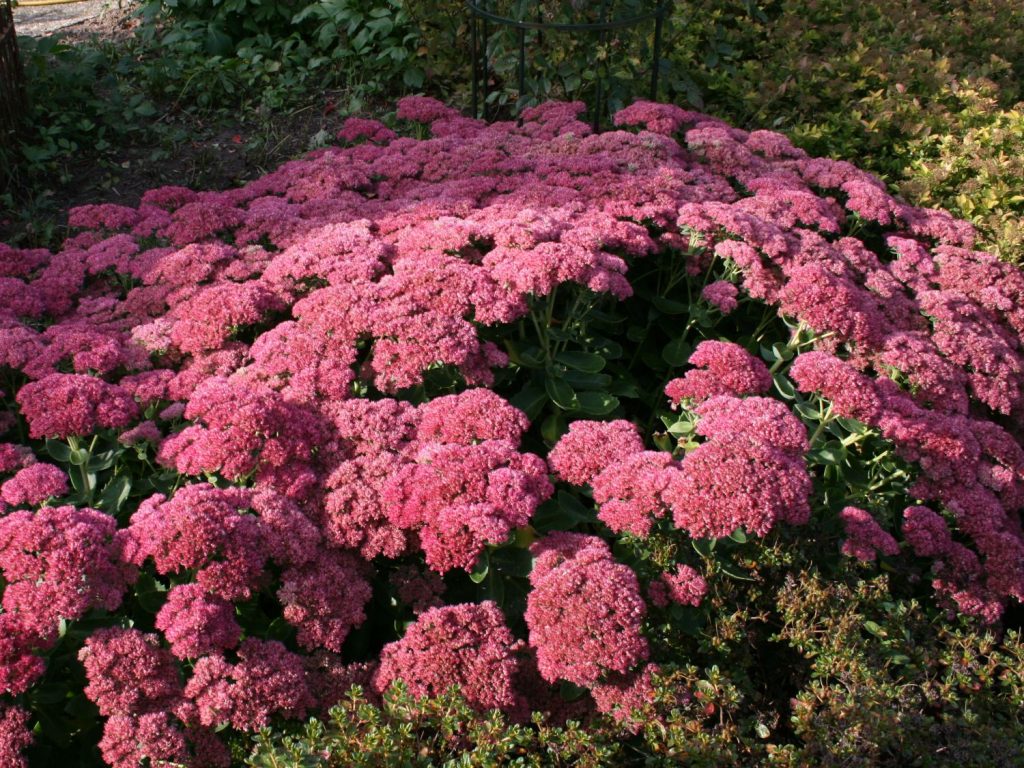
Stonecrop flower
general description
Sedum is a large genus of flowering plants from the jungle family.
Other names: sedum, hare cabbage, fever grass, "golden moss", young, squeaky, hernial grass.
Sedums are succulents that grow in subtropical and temperate climates. They prefer open spaces, they are found in forest glades, along the edges of bushes, on dry mountain slopes, ravines.
Their leaves in the process of evolution have learned to store water in case of drought. They are small, sometimes tiny, but fleshy, dense. The stems are also saturated with moisture.
The botanical diversity is great. The genus is mainly represented by perennial, less often biennial and annual grasses. Some species have developed into shrubs and dwarf shrubs. Stems are creeping and erect.
The star-shaped flowers of most species have 5 yellow or yellow-green petals. But there are representatives with 4 and 6 petals - burgundy, red, pink, purple, white, gray, white-pink, green.
There are 2 times more stamens than petals. After pollination and ripening, fruits are formed - multi-seeded leaflets (follicles) or berries.
Use in garden design
Sedum is considered one of the most beautiful autumn and pre-winter plants. Their peduncles, surviving until frost, shine like lighthouses against the background of a garden sprinkled with snow or frost.
Sedums are widely used in landscape design. This is due to the richness of shapes, sizes and colors, unpretentiousness and disease resistance.
Creeping low-growing species are an important element of alpine hills, tall erect varieties look great next to roses, astilbe, chrysanthemums, asters, periwinkle and other garden plants. They are also grown as indoor flowers.
Mixes, terrariums and "living pictures" with several species growing together are popular.
Varieties
The genus includes about 500 species, hundreds of varieties and hybrids. Sedum grows mainly in the northern hemisphere; it is also found south of the equator in South America and Africa.
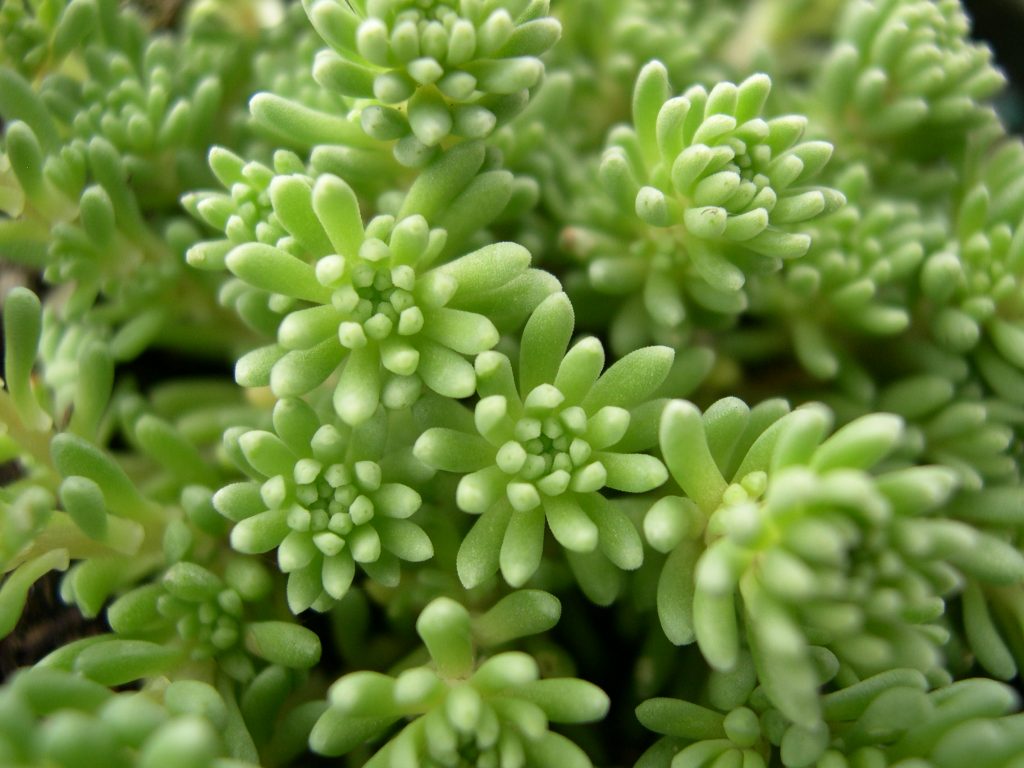
Sedum flower
The greatest diversity is observed in the Mediterranean, the Himalayas, Mexico, China.
White (Album)
Sedum album, as the name suggests, has flowers with white petals. It grows in northern latitudes, in crevices, on stony, well-drained soils.
The flowering period is July-August.
In nature, the perennial forms mat-like colonies in the form of a living carpet. Stems are short, densely leafy. During flowering, they elongate, changing color from green to pink-brown. In sunny places, the leaves, cylindrical with a rounded tip, also acquire a pinkish tint. Star-shaped flowers form dense, simple inflorescences - cymoses.
Coral Carpet is one of the most common white varieties. Ground cover plant. It reaches a height of only 3-7 cm, while forming a green carpet up to 60 cm wide. Ideal for a rock garden.
Red Cauli
Red-leaved hybrid with gorgeous, brightly colored small crimson-red flowers that take on a burgundy hue closer to winter.
It grows up to 20-30 cm, does not form colonies. Large inflorescences, similar to broccoli and reaching 10 cm in diameter, abundantly cover the bush.
The flowering period is up to 6 months, starting in the middle of summer. One of the most beautiful sedum plants in the garden in late autumn.
Prefers neutral or alkaline sandy and limestone soil, loam. Feels good outdoors, in direct sunlight. Does not require special care and watering, it is afraid of stagnant water under the roots.
White-pink (Alboroseum)
Shrub species, stem height from 50 to 85 cm. The tallest of stonecrops. Unpretentious to conditions, does not require fertile soil and does not need replanting. It can bloom in one place for 30 years or more. Winter hardy.
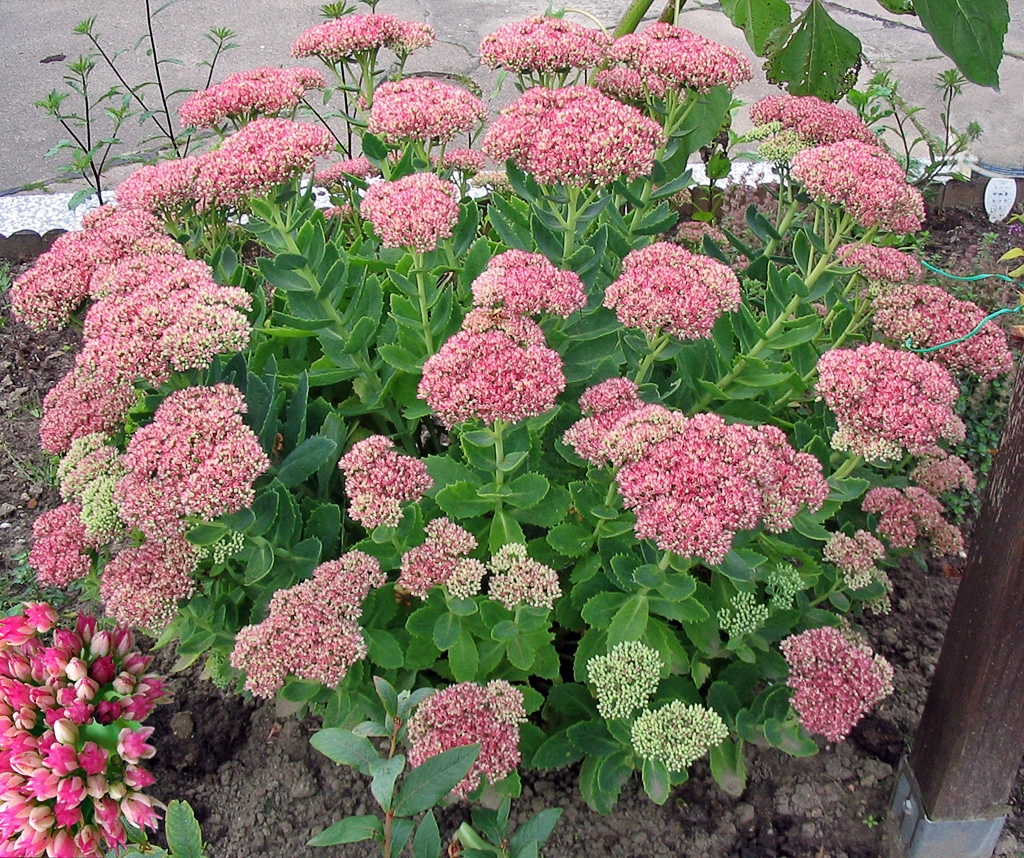
Sedum photo
Common varieties:
- Josie Aubergine
- Frosty Morn
- Mediovariegatum - bright yellow leaves with a green stripe along the edge. Bush up to 60 cm high.
Telephium
This name hides a large group of subspecies and varieties of stonecrop. Among them there are erect and ampelous plants, undersized (up to 20 cm) and bushy (over 60 cm). They usually grow outdoors.
Popular varieties are:
- Munstead Dark Red. Differs in large inflorescences that change color from white (bottom) to pink (in the middle) and red (at the top). The foliage takes on a bronze tint over time. It looks spectacular in late autumn. One of the rare stonecrops that can be planted with seeds - it has a high germination and survival rate.
- Mediovariegata (Mediovariegata) is a variegated species with variegated leaves and erect bushy shoots up to 60 cm high.
- Purple Emperor is a medium-sized bushy variety (30-60 cm). Purple Emperor is distinguished by purple leaves and large, densely packed purple flower head umbrellas. Long-lived perennial plant, drought tolerant. It needs a transplant every 5-6 years.
- Autumn Joy. According to the description, the hybrid is considered one of the best plants for decorating the garden in the pre-winter period. Blooms from mid-summer until winter. Due to its ease of growing, it is suitable for beginner gardeners and florists.
- Touchdown Teak. Unique in its own way with slender purple shoots growing up to 60 cm. Red-brown leaves are large, densely planted, fleshy. Unlike most stonecrops, it produces upward high peduncles with bright red flowers. Keeps shape until frost.
- Autumn Charm. Variegated variegated hybrid with gray-green toothed leaves, edged with a white border. By the end of summer, creamy buds appear, by mid-autumn giving way to red seed heads. The plant is medium-sized (35-45 cm). Dried inflorescences and variegated foliage retain their decorative qualities throughout the winter.
- Ice Ruffles (Ice Ruffles) - is distinguished by abundant flowering. Cream buds, collected in large corymbose inflorescences.Leaves are fleshy, dense, dark green with cream and red edging. In autumn they turn bronze, and the stems turn red.
- Strawberry and Cream is a low-growing variety. The height of the bush is up to 30 cm. The unopened buds are pink-red, and the flowers are pure white. Because of this, the inflorescences look two-colored. The variety is winter-hardy, does not require shelter in cold weather.
- Thunderhead is a bushy species characterized by huge crimson caps of bright colors. Lush umbrellas cover the entire bush, flowering lasts more than 8 weeks. Photophilous, loses brightness in the shade and releases few buds.
- Herbstfreude, or rabbit cabbage. Tall shrub up to 70 cm, straight stems, light green. Leaves 6 cm long, purple with a bluish tint. The flowers are small, pink at the beginning of flowering, then turn red.
Blue pearl
Ground cover type. Ideal for growing in front of a sun-facing green curb or for edging paths. The blue pearl forms a low, compact mound with fleshy, intensely colored blue-gray leaves that do not fade.
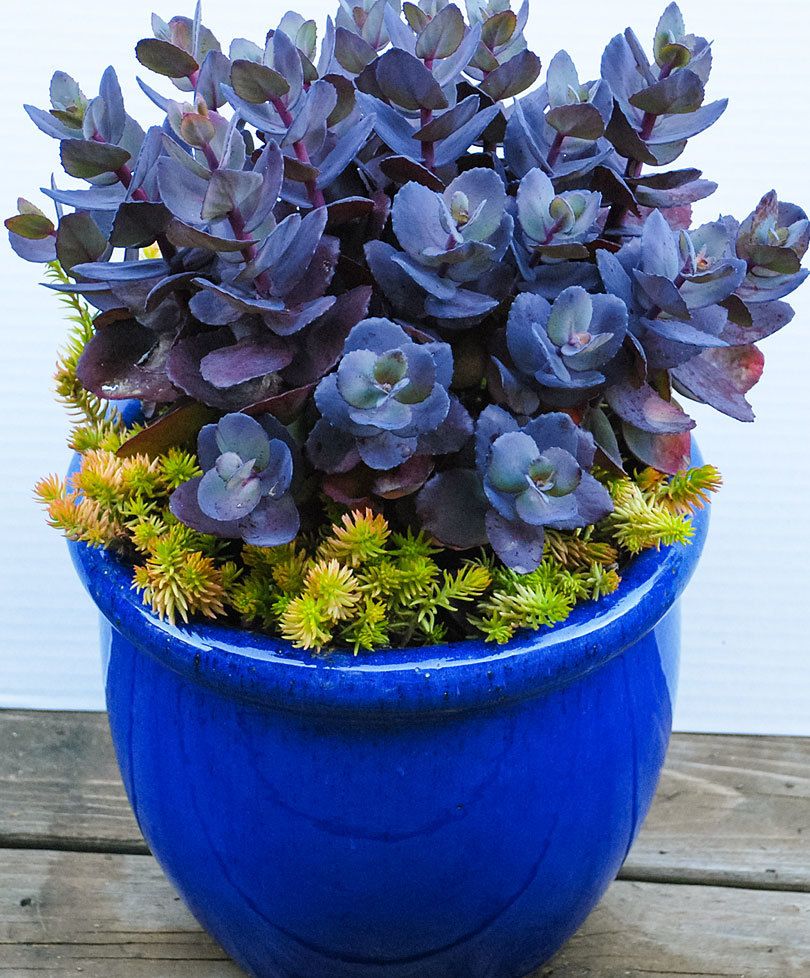
Sedum flower photo
Blooms from late summer all autumn, releasing large groups of bright pink flowers. Stems are strong, erect, 15-20 cm high.
Blue pearl is suitable for growing at home and in a flower garden on the street. Easily multiplies by dividing the bush. A good honey plant, attracts butterflies to the garden.
Rubrotinctum
Sedum red-colored includes many subspecies and varieties. The most popular is Aurora (rubrotinctum cv.aurora variegata).
A stunted succulent plant can grow on bare rocks, forming small colonies. Due to its Mexican origin, it does not tolerate frost well, therefore, in the middle lane, it is more suitable for growing indoors.
Leaves change color from green to red during the summer months as a defensive reaction to excess UV light. In mid-spring, bright yellow flowers appear between the stems. The modest fellow is unpretentious, easily tolerates a transplant.
Nussbaumer (Nussbaumerianum)
A very interesting elegant look with variegated leaves, whose color varies from pale green to yellow-orange.
Winner of the Award of Garden Merit from the Royal Horticultural Society of Great Britain.
Low-growing (20 cm) evergreen perennial shrub with beautiful rosettes of fleshy pointed 5 cm leaves, acquiring a golden hue at the tops.
It can form small cushion colonies up to 1 m wide. It blooms in spring, releasing spherical clusters of fragrant, star-shaped white flowers with pink anthers.
Despite its excellent decorative qualities, it is easy to grow. It can be planted in any soil: acidic, neutral, alkaline.
Xenox
This is a group of hybrids popular for decorating an autumn garden. Regular plants reach 30-40 cm. Colonies do not form, therefore they are suitable for creating living compositions with other types of flowers.
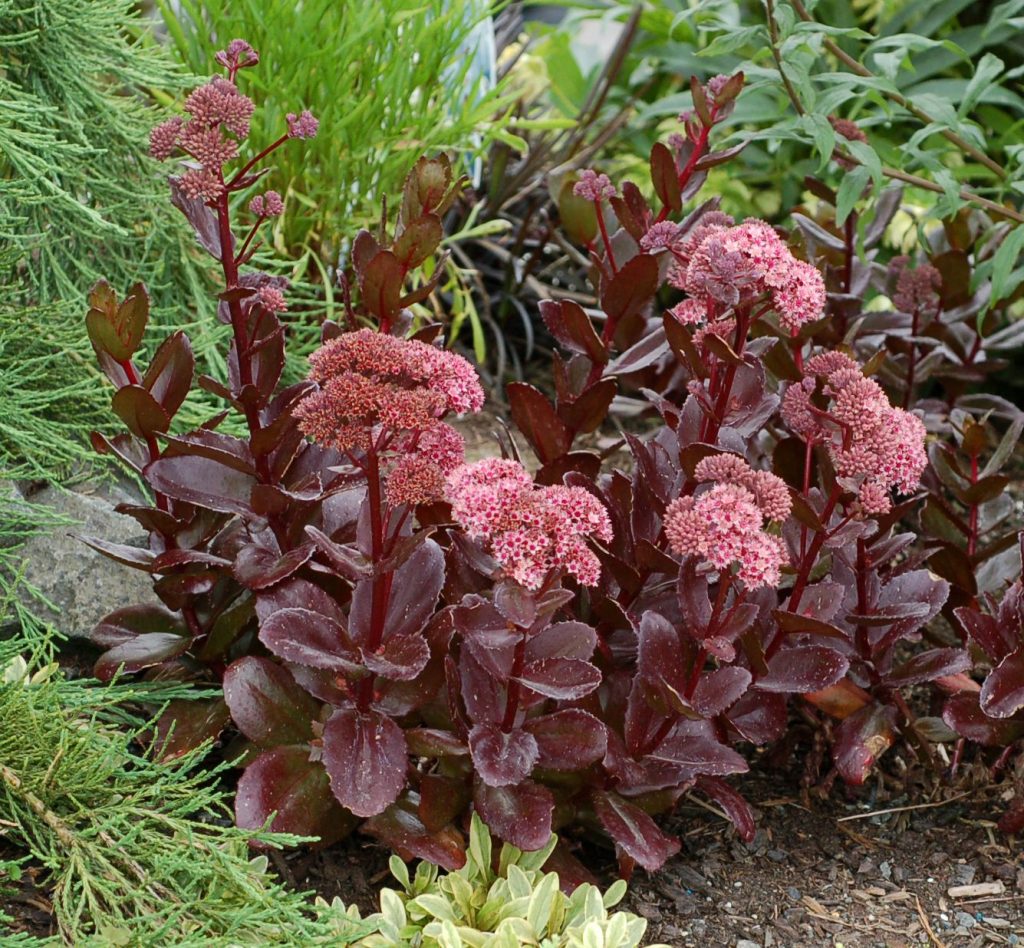
Sedum photo of flowers
The following hybrids are popular in the world:
- Telefium — the flowers are light pink.
- Yellow - yellow inflorescences.
- Iridescent - during flowering, petals of different shades are formed: brown, dark pink, orange, yellow.
Prominent (Spectabile)
It got its name for its bright colors, translated from Latin “Spectabile” means “attractive”. Pronunciation - Spectabil.
Bushes are high, up to 65 cm, straight thick stems, oval leaves with a jagged edge. Differs in the rapid growth of tubers.
The most common varieties:
- Brilliant - introduced in China in 1913. The ancestor of hundreds of other varieties. The bush is powerful and dense, up to 50 cm in height, the inflorescences are lush, pink. Blooms in September-October. Photophilous.
- Rosenteller (Rosenteller) - bush up to 40 cm tall, star-shaped flowers, have a crimson color, collected in the umbrella-flowering. Good honey plant.
- Neon (Neon) - so called because of the lilac-pink colors, very bright and lush. The bush is high, 50-60 cm. Loves light and light soils, winters well without shelter.
- Iceberg (Iceberg) is a low (up to 40 cm) bush with white-cream flowers, collected in umbellate inflorescences. Leaves are fleshy, light green. Blooms in August and early September. Photophilous, prefers fertile soils.
- Carmen (Carmen) is a dense bush up to 50 cm in height and 30-40 cm in width. Leaves are oval with jagged edges, dark at the bottom and light green closer to the top of the stem. The flowers are pink-red, small. The flowering period is from August to October.
- Stardust is a tall shrub with white, star-shaped flowers. Leaves are light green, dense. Keeps decorative all year round. Blooms from August to October.
False (Spurium)
The second name of the species is Caucasian sedum. It grows in Georgia, the North Caucasus, Armenia, as well as in Turkey (in the northern regions). Unpretentious to conditions, feels good even on rocky slopes with a minimum of nutritious soil. Very frost-resistant species.
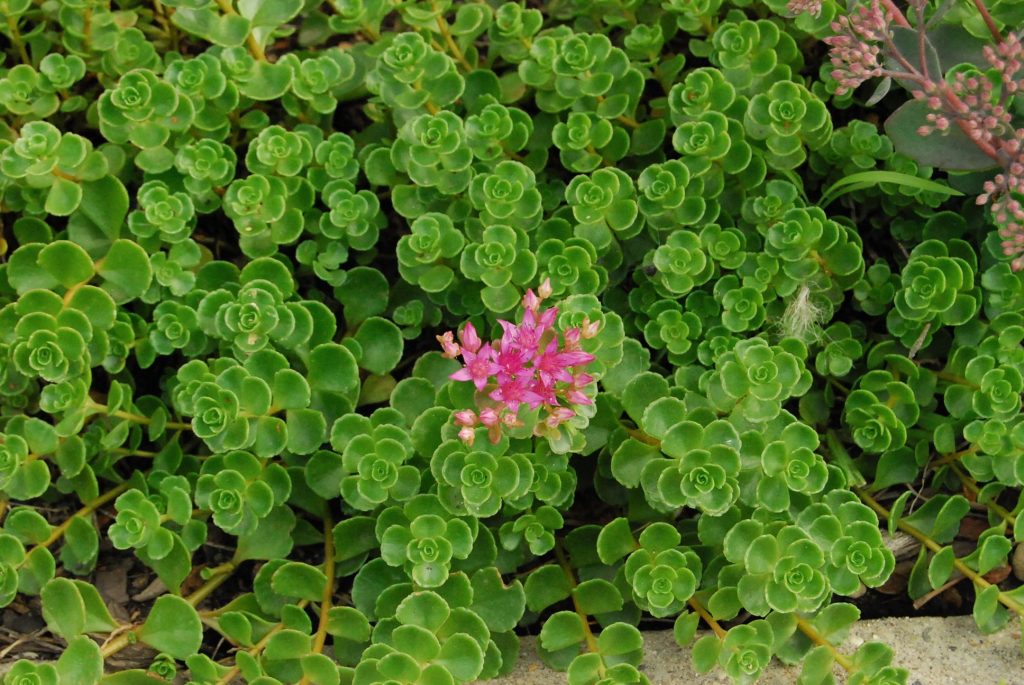
Sedum varieties and species with photos
The most common varieties:
- Spurium Tricolor (Tricolor) - forms a carpet of leaves, the height of the stems 10-15 cm. Each leaf is bordered by a strip that changes color according to the season. Hence the name - tricolor. The brightness of the color depends on the lighting. The most dry type.
- Dragon Blood (Dragons Blood) - ground cover with small red-burgundy leaves. Prefers sandy loose soils, winters well in the ground. Not susceptible to attacks by insect pests.
- Voodoo (Voodoo) - grows in the Crimea, Western Europe, Asia Minor. The leaves are burgundy, glossy, opposite. The length of the shoots is up to 15 cm. The stems spread along the ground, have adventitious roots.
- Raspberry - bush sedum, up to 25 cm high. Stems are dense, with flat dark green leaves. Flowers up to 7 cm in diameter, begin to bloom in the second year.
- Purple carpet - has the second name Skripun. The leaves are serrated, fleshy, with a bluish bloom. The flowers are bright, pink-scarlet, bloom in late summer. The height of the bush is 28-33 cm.
- Fuldaglut is a creeping variety with green-bronze foliage and relatively large red flowers.
Groundcover, creeping and ampelous
Siebold (sieboldii) is a deciduous compact perennial native to Japan. Poorly tolerates large frosts, has rounded leaves with a bluish edging. Pink flowers appear in the fall.
Other popular representatives:
- Dwarf: Dark Magic, Winky;
- Rocky (reflexum): Angelina, Blue Spruce, Cristatum, Blue Forest, cauticola Lidakense;
- Nevii: Silver Frost, Starfish, or Sea Star;
- Sunsparkler: Blue Elf, Firecracker, Firecracker, Sunsparkler Dazzleberry, Wildfire.
This large group also includes the following species and varieties found on the market: Lydian (mossy) (lydium), acrid or Stone rose (acre), Steel (Stahl) (stahlii), Six-row (sexangulare), escaping (stoloniferum), creeping (humifusum), linear (lineare), Morgan (morganianum), spathulifolium, thick-leaved or pachyphyllum (pachyphyllum), Spanish or gray (hispanicum), Makinoi (makinoi), thick-branched (pachyclados), sedme cyaneum), hexagonal or hexagonal (sexangulare), Rubens Lizard or rubens Lizard, Lime Zinger, Bertram Anderson hybrid, Oregon or cream (oregonense), Forster (forsteranum), Weinbergii (weinbergii) , dasyphyllum, carneum, treleasei, anglicum, hakonense Chocolate Ball, clavatum or clavatum, thick-leaved or dasiphyllum d asyphyllum), compressed or compressum (compressum), griseum (griseum), multiceps (multiceps), hintonii (hintonii), scaly (furfuraceum), spathulifolium Cape Blanco.
Shrub and semi-shrub
Populifolium is the only Siberian semi-shrub species. High half-meter shoots lignify with age. The flat leaves are shaped like poplar leaves.
Also found in garden plots: tenacious (aizoon), Middendorf (middendorfianum), Linda Windsor (Linda Windsor), Pinky (Pinky), Kamchatka Caramel (kamtschaticum Caramel), Adolph (adolphii), Oriental Dancer (Oriental Dancer), hybrid Jose Oberdzhin (Jose Aubergine), picolette (picolette), Sultan (Sultan), Elina (Eline), Frosted Fire hybrid (Frosted Fire).
Purchase and adaptation
You can buy an adult plant in the store, buy a bag of seeds, or ask for seedlings from gardeners you know. Many species grow right on the street: both in the countryside and in the city (in flower beds or wasteland).
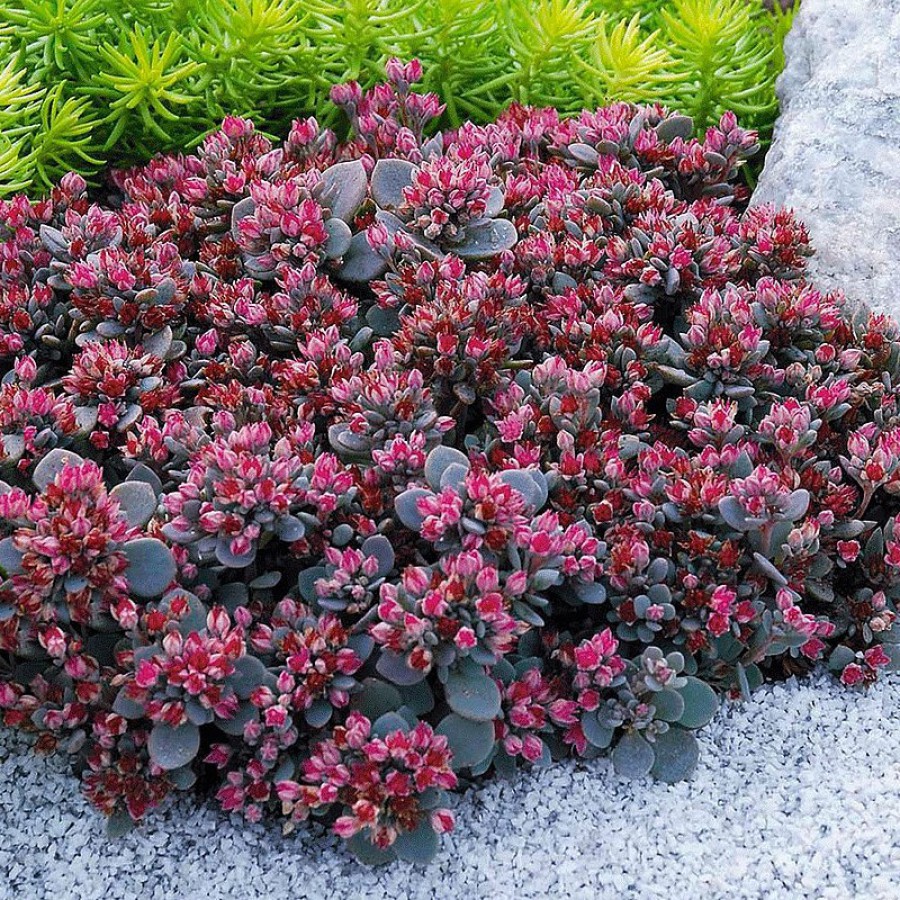
Sedum varieties and types
The cost directly depends on the rarity and size of a particular specimen. For instance:
- A very beautiful hybrid Carl with flowering stems 20-50 cm high, densely covered with bright pink flowers, is sold in the range of 200-400 rubles.
- They ask for a little more for stonecrop, rocky Silver, which is distinguished by gray silvery leaves.
- The spectacular Chocolate Ball variety, whose small branches of chocolate color look like miniature Christmas trees, costs 250-350 rubles.
Representatives of the sedum genus are famous for their vitality and do not require special adaptation measures. But many trading companies add stimulants and fertilizers to improve the presentation of flowers. If there are doubts about the quality of the soil, it is advisable to replace it.
Don't forget to check for drainage in the pot - this is an important parameter for the health of succulents.
Landing rules
The plant is planted in open ground at the end of May, when the threat of night frosts blows. This is especially true for young seedlings grown from seeds. They are too weak to fight the cold. Therefore, it is better not to risk it and wait for warmer weather.
Selection of soil and location
Sedum is unpretentious to growing conditions - they grow and bloom, both in the bright sun and in the shade. The main thing is that the place is open - it is easier to take care of. But with a lack of light, the colors of the leaves and shoots will be less bright.
The soil can be anything, even rocky, but some types are still more demanding than others. For example, sedum creeping and forked sedum have to be replanted regularly as the soil becomes depleted. These plants love an abundance of nutrients.
Ampel species are grown on alpine hills or in flowerpots, the soil for them is mixed with baking powder (perlite, vermiculite, expanded clay) for a better outflow of moisture.
The best option is a mixture of turf and humus soil and coarse sand. When landing on the bottom of the pit, drainage must be laid. With this composition of the substrate, frequent transplantation of the plant will not be needed. Some species can grow in one place for decades.
The necessary conditions
Sedums are hardy succulents. They tolerate frost well down to -20 ... -30 ° C. But this is subject to a stable microclimate. Plants can get sick and even die if thaws were frequent in winter, and the snow cover is not large enough.
Attention! It is necessary to carefully approach the autumn mulching of the soil around the sedums. On the one hand, extra protection will not hurt. What if abnormal frosts hit? On the other hand, during a mild winter, under a layer of mulch, the roots can trample due to excess moisture.
Humidity
Sedum prefers dry air. Artificial increase in humidity (spraying, installing trays with water) causes disease, the flower rots and dies.
When it gets cold, watering should be stopped altogether, and the air should be kept as dry as possible.
Temperature
Street varieties are well adapted, tolerate both heat and cold, winter in the ground even at -35 ° C. The optimum temperature in summer is + 20-25 ° С.
Indoor sedums are more delicate, lowering to + 10 ° C entails a bunch of diseases. Plants stop developing, gradually dry out and die. In summer, the room should be + 22-26 ° С, in winter + 14-17 ° С.
Lighting
Sedum easily tolerates direct sunlight. The only exceptions are the youngest plants, rooted cuttings and shoots that have just emerged from seeds. They need to be shaded from the direct sun.
The rules for growing garden sedum do not dictate the level of lighting at all. They feel good both in the open sun and in the shade.
If the plant stops growing and does not bloom well, it is best to transplant it elsewhere.
Care
In order for the sedum to grow beautifully, 3 essential conditions must be met:

Sedums varieties and types of photos with the name
- choose the right soil and equip drainage;
- find a sunny place for a bush;
- water in moderation, without fanaticism.
If the soil is greasy, there is little light, and there is a lot of water, the stems will begin to stretch and turn pale.
Sedum is an excellent marker for growing at home other more expensive flowers that require lighting. Growing up and thinning too quickly? This means that in this place the sun's rays are not enough for light-loving plants.
Top dressing
Sedum is self-sufficient and not picky about feeding. At the same time, he accepts them with gratitude. With the addition of additional nutrients, the already strong stems and leaves become even thicker and the color richer.
This only applies to green and gray. Other shades - pink, silvery-gray, reddish - depend on the light intensity. The more it is, the brighter the color.
If the soils are poor, top dressing is carried out in the spring, at the beginning of the active growing season, and in the fall to prepare for wintering.
Either special fertilizers for succulents or an organic solution are used. Rotted cow dung or chicken droppings are insisted in water in a ratio of 1:10 and 1:20, respectively.
Watering
Common sedum (like most other species), which grows in open ground, does not need special watering. There is enough moisture falling with rain and dew. An exception is a drought lasting more than 2 weeks.
At room maintenance, watering should be moderate - only after the top layer of the soil has dried.
Transfer
After 5 years of growth in a flower garden in one place, sedum begins to degenerate. The situation is rescued in two ways: the bush is rejuvenated by removing old stems and adding fresh soil, or transplanted to a fresh site.
To do this, dig a hole 2 times wider than the root system, add compost or leafy soil to it and plant the dug out specimen. When it takes root, they cut off the green mass, making way for young shoots.
Pot plant transplant:
- A container is selected 1-2 cm wider than the roots.
- At the bottom, drainage is equipped - fragments of ceramics or broken red brick. The thickness of the drainage layer depends on the size of the tank, but not less than 1 cm.
- Place the plant in a pot. Any soil will do, even stony ones. If the soil is poor, apply complex fertilizer according to the instructions.
- It is well watered and placed in a lighted place for the adaptation period, but not under direct sun.
Pruning
During the winter, due to lack of lighting, the stems stretch out, the plants lose their decorative appearance. To rectify the situation, stonecrops must be cut off in the spring. This is only for their good: growth is activated, the lower buds wake up, the stems become thicker and denser.
Cutting the stems is carried out at a quarter of the length. The resulting cuttings can be used for propagation. It is enough to place them in cups or pots. Every 5-6 years, high-growing succulents in the garden rejuvenate - they are pruned almost at the root.
Breeding methods
Sedum reproduces in all ways that exist in nature. They are ideal plants for lazy gardeners. It is enough to tear off a leaf and stick it into the ground, as with a high degree of probability it will take root in a new place.

Sedum sedum
Seeds
Although this method is provided by nature, it is the most unreliable of the existing ones. At home, and even more so on the street, it is difficult to recreate the microclimate and take into account all the factors. Growing sedum from seeds is advisable if it is not possible to get a cutting or acquire an adult plant.
Before planting seeds, they must be stratified. That is, to simulate winter, otherwise biological processes will not turn on and shoots will not germinate.
To do this, the planting material is cleaned of debris, peel and pulp, soaked in cold water for up to half a day, placed in a sterilized (to exclude mold damage) loose moist substrate (vermiculite, moss, sand, peat) and refrigerated for 2-3 months. It is desirable that the temperature does not drop below zero.
Further procedure:
- After stratification, seeds are sown on prepared soil, slightly sprinkled with earth.
- Moisten the soil with a spray gun.
- Make a mini greenhouse to retain moisture.
- Place in a cold place (5-7 ° C) for 2 weeks.
- Every day, a container with seeds is taken out, aired for several minutes and the soil is re-moistened.
- After the cold period, the container is transferred to the room. At 18-20 ° C, seedlings will appear within a month.
As you can see, germination requires specific conditions, precisely controlled equipment (refrigerator), and a sterile substrate.
Seed germination is low, they can rot, mold. If the planting material was collected on a flower garden, a slightly different plant may eventually grow. This is due to cross-pollination.
Cuttings
This is the smartest breeding method. When the necessary conditions are created, the success of the operation approaches 100 percent. Cuttings have a lot of vitality: they are filled with moisture, nutrients, and have sufficient "building material" for the formation of roots.
Sedum can be propagated in this way at any time of the year. If planting is planned to be carried out in the open field on a flower bed or in a garden, it is better to do cuttings in the spring, so that the plant has time to gain green mass before winter.
At home, there is no fundamental difference, but the stalk will develop better in sunlight.
Procedure:
- The top of the stem is cut off from an adult bush. The cuttings should be healthy, with at least 4-6 leaves.
- I pluck off the 2 bottom leaves to make room for root growth.
- Placed in water.
- After the roots appear, they are planted in a permanent place of growth.
- Or they immediately plant the stalk in the flower garden. In this case, it is regularly watered.
Winter cuttings are carried out after flowering, followed by planting in the spring of next year:
- Well-formed stems are cut.
- Dried until old leaves fall off and new shoots with roots appear.
- When the shoots grow up, they are separated from the stem from the roots and transplanted into containers for a while. Winter in northern and temperate latitudes is kept on the windowsill, in the south - in partial shade.
- It is advisable to transplant it into open ground in May, along with tomatoes and peppers, when the soil has warmed up enough.
Sheet
Although stonecrop leaves are small, they are also capable of taking roots. The procedure is similar to grafting. To make it easier to root with a leaf, it is recommended to use rooting stimulants, for example, "Kornevin".
By dividing an adult plant
When there is free space for growth, many types of stonecrops form a green carpet or pillow, growing up to several meters. For reproduction, it is enough to separate a small part from the mother bush.
The transfer will take a couple of minutes. In this way, sedum reproduces most easily. But if an adult plant is sick, infections or pests will move to a new location.
Rhizome
The roots of most types of stonecrops (especially indoor) are thin, threadlike. But there are bush forms with a well-developed root system. If the plant is already old and needs to be removed, after digging up, you can cut off several roots with buds from which the shoots hatch, and plant in a new place. Preliminarily, the cut is disinfected, for example, with a fungicide, and for several hours it is dried in the shade.
Healing properties
People have long understood that there is healing power in stonecrop. The plant began to be used in medicine, discovering new useful properties.
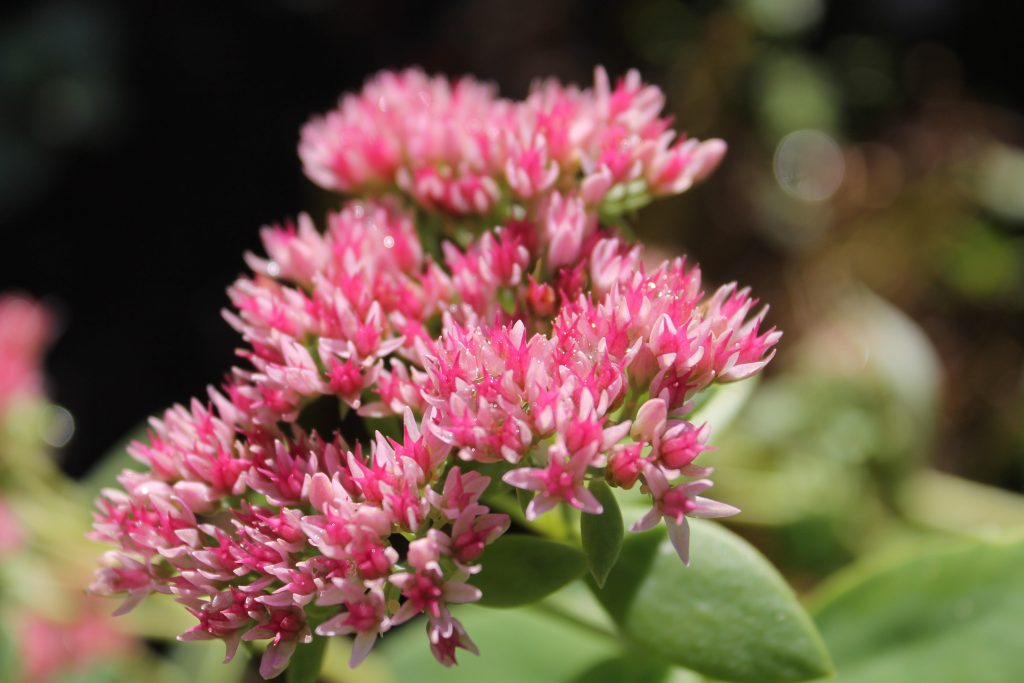
Sedum rubrotinctum
Until now, all of them have not been fully studied. For example, it has recently been scientifically proven that some species contain substances that prevent the formation of tumors.
Chemical composition
The plant is rich in medicinal substances, it is actively used in medicine. Many folk remedies do not do without stonecrop.
- Organic acids - acetic, malic, isolimonic, oxalic, glyceric and succinic.It is a "barrier" for pathogenic bacteria, a natural antibiotic that stimulates the production of protective functions in the cells of the body. Acids are involved in liver detoxification, removing waste products and purifying the blood.
- Glycosides of kaempferol, quercetin, isorhamnetin, myricetin are sugar carriers, they control blood glucose levels, improve the functioning of the digestive system.
- Alkaloids (sedamine, seditin, nicotine, saponin) - restore the heart rate, normalize blood pressure, have a sedative effect.
- Arbutin - normalizes the urinary system, a powerful antiseptic.
- Phenolic compounds - improve the condition of blood vessels and capillaries, have anti-inflammatory and antitumor properties. People cannot synthesize these substances, they get them only from plant products.
- Micro-and macroelements - participate in all processes of the body, without them, its vital activity is impossible.
- Calcium salts - strengthens the skeletal system.
- Vitamins A, C are powerful antioxidants that increase immunity.
Most types of sedum are edible: leaves and shoots are added to salads. They are widely used in Western European cuisine. They are appreciated for their piquant taste and richness of nutrients.
Types of sedum used for medicinal purposes
Although all plant varieties contain certain useful substances, only seven of them are used in medicine. Each type is useful and has its own healing properties:
- Ordinary. In folk medicine, the stem and roots of the plant are used. Means made from them heal wounds. Ointments are also prepared for the treatment of burns and the elimination of calluses.
- Purple. Medicinal decoctions are prepared from it for oral administration or mouthwash. Healing ointments and powders are prepared from the leaves. It is part of the remedies for worms and ointments for hemorrhoids.
- Large. Alcohol tinctures are made from the green mass prepared in advance. They are used for diseases of the genitourinary system. The infusion is also useful for heart problems. Gruel made from crushed flowers is used to combat infertility in women. The crushed roots and leaves are used for poultices to help with muscle aches and colds.
- Prominent. It is used to make remedies for the treatment of burns, wounds, skin diseases, even depriving. Prepare oily liquids against eczema, boils, abscesses.
- Caustic. It is a poisonous species, but when properly processed it becomes medicinal. It is used to prepare powerful pain relievers. The plant also heals burns and wounds, accelerating their healing. Each drug has severe contraindications. Since ancient times, there is a sign that the caustic sedum woven into a wreath on Ivan Kupala cures the most serious ailments.
- Tenacious. This species is a wonderful honey plant; only its flowers are used in folk medicine. Decoctions are prepared from them, used for dysentery and diarrhea. They also help with kidney disease.
- Pink. Dried flowers are used as medicinal raw materials. Medicines from them are used to stop bleeding, eliminate inflammation in the body, heal wounds, and improve immunity. The use of preparations from pink stonecrop is patented to relieve tumors and skin inflammation.
Diseases and pests: treatment and prevention
| Symptoms | Treatment | Prophylaxis | |
| Sawfly caterpillars | Leaves are eaten away by grooves | Preparations "Aktellik", "Commander", "Iskra" | Regular inspection |
| Thrips | The tops of the stems are curved | Preparations "Actellic", "Abamectin", "Malathion" | Regular inspection |
| Aphid | Small insects in leaf axils and on flowers | Remove mechanically, treat with soapy tar solution and Biotlin preparation | Regular inspection |
| Nematodes | Roots are affected, the plant withers and dies | It is not treated. The plant is destroyed along with the soil | Do not overfill or overfeed the plant with fertilizers |
| Fungal diseases | Dark spots on leaves and stems | Cut off and burn the affected areas, treat with Topaz, Forecast, Chistotsvet, Bordeaux liquid | Correct irrigation regime, do not overmoisten |
Sedum is one of the most unpretentious plants for indoor and outdoor cultivation. The richness of species, varieties and hybrids opens up a wide choice for landscape gardening.
The decorative properties are preserved until stable snow cover. In a number of countries they are used for food.

